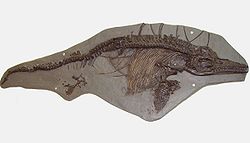- Parvipelvia
-
Parvipelvia
Temporal range: Late Triassic-Late Cretaceous, 210–93.5 Ma
Ichthyosaurus breviceps fossil Scientific classification 
Kingdom: Animalia Phylum: Chordata Class: Reptilia Order: †Ichthyosauria clade: 1999 Subgroups Parvipelvia (Latin for "little pelvis" - parvus meaning "little" and pelvis meaning "pelvis") is an extinct clade of euichthyosaur ichthyosaurs from the Late Triassic to the early Late Cretaceous (middle Norian - Cenomanian) of Asia, Australia, Europe, North America and South America. Named by Ryosuke Motani, in 1999, it contains the basal taxa like Macgowania and Hudsonelpidia.[1] Maisch and Matzke (2000) found in their analysis 7 synapomorphies that support Parvipelvia. They also found 10 synapomorphies that support the existence of post-Triassic clade of ichthyosaurs (all parvipelvians excluding Macgowania and Hudsonelpidia), for which the name Neoichthyosauria was found to be available.[2]
Phylogeny
Parvipelvia is a node-based taxon defined in 1999 as "the last common ancestor of Hudsonelpidia, Macgowania, Ichthyosaurus and all of its descendants".[1] Maisch and Matzke (2000) also defined Neoichthyosauria which is a node-based taxon originally named by P. Martin Sander in 2000, as "the last common ancestor of Temnodontosaurus trigonodon and Ophthalmosaurus icenicus and all of its descendants".[2] The cladograms below follows Motani (1999) and Maisch and Matzke (2000).[1][2]
Parvipelvia Macgowania
Hudsonelpidia
Suevoleviathan
Neoichthyosauria (by definition) Eurhinosauria
Thunnosauria
Parvipelvia Macgowania
Hudsonelpidia
Neoichthyosauria Leptopterygiidae
Suevoleviathan
Thunnosauria
References
- ^ a b c Ryosuke Motani (1999). "Phylogeny of the Ichthyopterygia". Journal of Vertebrate Paleontology 19 (3): 472–495. http://mygeologypage.ucdavis.edu/motani/pdf/Motani1999c.pdf.
- ^ a b c Michael W. Maisch and Andreas T. Matzke (2000). "The Ichthyosauria". Stuttgarter Beiträge zur Naturkunde: Serie B 298: 1-159. http://www.naturkundemuseum-bw.de/stuttgart/pdf/b_pdf/B298.pdf.

This Ichthyosaur-related article is a stub. You can help Wikipedia by expanding it.
